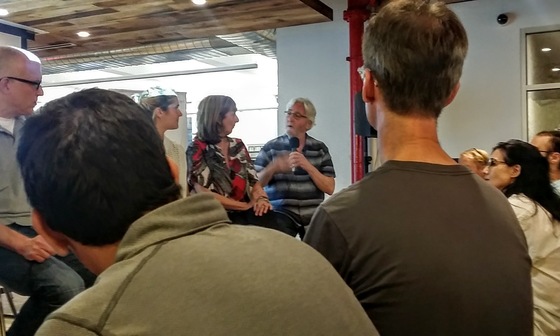Living in the Time of Audience Rebellion: No One Wants to Pay for Content
By Dennis Clemente
NEW YORK–What’s the future of content? That was the topic at the NY Content Meetup last July 28 at Samsung Accelerator in midtown Manhattan. The title seems ominous — but it has to be. After all, there’s just too much content out there for everyone to consume–and for those in the business of providing content, less and less opportunities to monetize their content. One thing that can save content is good storytelling, despite some ugly realities.
“We’re in the midst of an audience rebellion,” Kirk Cheyfitz said as the moderator of an impressive panel of content marketers. He is the CEO and founder of Story Worldwide, a digital-first ad agency, which has integrated journalistic storytelling, with advertising to tell brands’ stories in every media channel. Cheyfitz has extensive experience in journalism and has started and runs various media agencies.
It’s true. No one wants to pay for content. Not only that, people also want control of what they see and hear. “To force people’s attention is over,” he added. It doesn’t help that people don’t get your content directly to your site anymore. Your content gets linked on, say, Twitter. There are fewer people actually going to sites as social networks have become the default place to go to for newsfeeds, even beyond personal cat postings. And if you think people will click on those banner ads, think again. And we haven’t even mentioned ad blockers.
In a panel of creative people in the content business, there’s always a way.
“Give them some value. Be the destination,” Cheyfitz said.
The youngest in the panel, Bailey Richardson, offered the future as “you being the TV network,” as she also points how Pop-Up Magazine is making journalists, even print journalists not used to the camera or radio, to broadcast the news themselves live. She was one of the early employees at Instagram, where she worked on the community team.
With Pop-Up’s “phone stories” (directly to you), the news becomes very personal, introducing emotion to the (experience).”
Richardson was joined by Jeff Gomez, founder at transmedia Starlight Runner, Mike Knowlton, president and founder at Murmur, a next-generation storytelling studio; Joanne Tombrakos, chief storyteller and business development consultant, and Matt Wellschlager, VP Marketing at Cerosdotcom, an interactive content marketing software company.
The free-flowing conversation resulted in some great insights and new terms on how you can push content that people will listen, read and watch.
- Take on a micro-narrative approach
- Where is Harry Potter now? (To stay relevant), it’s now in Lego Games where it’s the gateway drug for young people go before they go to the (Harry Potter) books and movies
- Content is the totality, what people are perceiving
- Work on the Plurals — those who grew completely internet native
- (Address) the different you in different social networks
- Do superpositioning. (Example) is Black Lives Matter.
- Make use of agile /lean development. See if you can fail faster (so you can recover faster)
- The future of content? Check out why people think mobile wallets is the future.
- “Listen” to your blind spots
- Difference of actual story and content? Content is a photo, moments–not always the long narrative arc. Some are primed for content but are not stories
